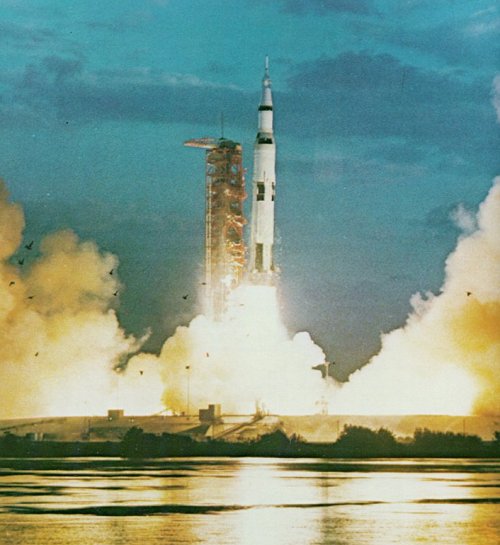
ARTIFICIAL STORMS AT THE ARM FARM
The connections between the ground and the towering space vehicle posed a tricky problem. An umbilical tower, even higher than the vehicle itself, was required to support an array of swingarms that at various levels would carry the cables and the pneumatic, fueling, and venting lines to the rocket stages and to the spacecraft. The swingarms had to be in place during final countdown, but in the last moments they had to be turned out of the way to permit the rocket to rise. There was always the possibility, however, of some trouble after the swingarms had been disconnected. For instance, the holddown mechanism would release the rocket only after all five engines of the first stage produced full power. lf this condition was not attained within a few seconds, all engines would shut down. In such a situation, unless special provisions were made for reattachment of some swingarms, Launch Control would be unable to "safe" the vehicle and remove the flight crew from its precarious perch atop a potential bomb.These considerations led to the establishment, at Marshall, of a special Swingarm Test Facility, where detachment and reconnection of various arms was tested under brutally realistic conditions. On the "Arm Farm" extreme conditions (such as a launch scrub during an approaching Florida thunderstorm) could be simulated. Artificial rain was blown by aircraft propellers against the swingarms and their interconnect plugs, while the vehicle portion was moved back and forth, left and right, simulating the swaying motions that the towering rocket would display during a storm.
Throughout Saturn V's operational life, its developers felt a relentless pressure to increase its payload capability. At first, the continually growing weight of the LM (resulting mainly from additional operational features and redundancy) was the prime reason. Later, after the first successful lunar landing, the appetite for longer lunar stay times grew. Scientists wanted landing sites at higher lunar latitudes, and astronauts like tourists everywhere wanted a rental car at their destination. How well this growth demand was met is shown by a pair of numbers: The Saturn V that carried Apollo 8 to the Moon had a total payload above the IU of Iess than 80.000 pounds; in comparison, the Saturn that launched the last lunar mission, Apollo 17, had a payload of 116,000 pounds.

| Silhouetted by the glare of the first Saturn V launch, a flock of birds calmly conducts its dawn patrol of the lagoon. As the vehicle begins to clear the launch pad, several more seconds will pass before the crashing roar reaches the flock. This is Apollo 4, the first "all up" test of the launch vehicle and spacecraft, proving out their flight compatibility in an unmanned Earth-orbiting mission. |
| Next |